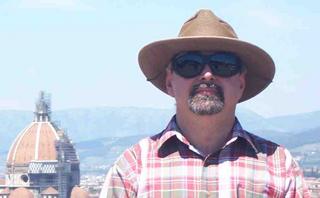Friday, November 10, 2006
Speaking of Bookbags,
as T.S. O'Rama is doing over at Video meliora, proboque; Deteriora sequor, I have finished Truth and Tolerance by (then) Cardinal Ratzinger. And I'm almost through The Christian and Anxiety by Hans Urs von Balthasar. The latter is heavy going, especially the last section, which is a metaphysical analysis of anxiety. Even re-reading passages doesn't get me much further forward. Too bad I slid through that class in Metaphysics thirty-some years ago.
Thursday, November 09, 2006
Autumn
What is it about this season that so lifts me up? It is a season of fading and dying and going away. And yet this is the season I enjoy the most. We don't get much of a Fall here compared to back East. But this has been a pleasant one nonetheless.
The colours are the obvious attraction: greens give way to yellows, browns, oranges, reds, and, yes, even some near-maroons. They're mostly lawn carpeting now, though a few trees stubbornly hold on after the winds of a couple of weeks ago and the recent heavy rains. There are, of course, biological and chemical reasons for these changes. But what are God's reasons? Why such beautiful display before the sleep of winter? That's something to ponder.
From childhood I remember the excitement of a new school year starting; and a new NFL season (go Chargers!). Now in Canada it's the beginning of hockey (I can breathe again). So Fall is also a season of beginnings. The Yin to Spring's Yang. Some things only properly begin at the end of the year, it seems.
So with thoughts of retirement and new beginnings, I ponder the meaning of Autumn.
The colours are the obvious attraction: greens give way to yellows, browns, oranges, reds, and, yes, even some near-maroons. They're mostly lawn carpeting now, though a few trees stubbornly hold on after the winds of a couple of weeks ago and the recent heavy rains. There are, of course, biological and chemical reasons for these changes. But what are God's reasons? Why such beautiful display before the sleep of winter? That's something to ponder.
From childhood I remember the excitement of a new school year starting; and a new NFL season (go Chargers!). Now in Canada it's the beginning of hockey (I can breathe again). So Fall is also a season of beginnings. The Yin to Spring's Yang. Some things only properly begin at the end of the year, it seems.
So with thoughts of retirement and new beginnings, I ponder the meaning of Autumn.
Saturday, October 07, 2006
It is Better to Light One Candle Than to Curse the Darkness
I learned that from the Christophers. And in that spirit I am admonished by Mike Aquilina's post on The Way of the Fathers blog.
I was asking questions and offering precious little in the way of answers the other day. One of the questions was "What is the best way for us to help [Christians and others who have been held hostage in Islamic lands]?" And Mike has an answer: support CNEWA.
So there you go:
I was asking questions and offering precious little in the way of answers the other day. One of the questions was "What is the best way for us to help [Christians and others who have been held hostage in Islamic lands]?" And Mike has an answer: support CNEWA.
So there you go:
““Ask, and it will be given you; seek, and you will find; knock, and it will be opened to you.”
(Matt 7:7 RSV)
Monday, October 02, 2006
I Left My Heart...
So we're waiting to disembark for a few hours in (you guessed it) San Francisco. We're close enough to the Fisherman's Wharf area that we'll just walk over there.
The two days at sea were fine. The wife (lovingly known as "Momma") played as many games as the schedule would allow. We came close to winnning the "Name That Beatles Tune" contest last night. Rats! I can't believe we missed the clue for Back in the USSR. Anyway, we had a bit of a sing-along after that.
Tonight will be our last night on-board. We pick up a rental car in L.A. tomorrow morning and head North. We should get back home by Thursday night. Too bad we can't make the entire voyage (Auckland, N.Z.).
The two days at sea were fine. The wife (lovingly known as "Momma") played as many games as the schedule would allow. We came close to winnning the "Name That Beatles Tune" contest last night. Rats! I can't believe we missed the clue for Back in the USSR. Anyway, we had a bit of a sing-along after that.
Tonight will be our last night on-board. We pick up a rental car in L.A. tomorrow morning and head North. We should get back home by Thursday night. Too bad we can't make the entire voyage (Auckland, N.Z.).
Friday, September 29, 2006
What He Said
The issue of Moderate Muslims (who are they and what can we do to help them?) continues to puzzle me. Read Father Neuhaus' latest blog entry for some perspective. (We're leaving for the ship in an hour or so and I should be getting ready. Procrastination: I'll write about it another time.)
Thursday, September 28, 2006
This Looks Interesting
If you like Venn diagrams, that is. John DaFiesole at Disputations has his own take on the Pope and Islam controversy.
It does seem to me that there are some questions that should be answered before we can draw conclusions about what happened and what it means (Other than the first question, my answers are still very tentative):
1. Did the Pope intend to insult Islam or Muslims? (He says no and I accept this.)
2. Did he anticipate the reaction?
I'm not sure. Did any of the Vatican "apologies" express surprise?
3. Why did he cite this particular quotation and not some other?
There's been some speculation about this. I'm not aware of the Holy Father has
addressed this directly himself. The fact that he hasn't withdrawn or amended
the citation (yet) might be salient. His overarching purpose in the address was
to direct attention to the crippling of dialogue between the West and the rest of
the (religious) world. And that, he argues, is because the Western tradition has
divorced reason and faith, thus rendering conversation with believers
increasingly impossible. In that context the citation just shows the opposite error
(fideism in contrast to rationalism), in this case imputed to Islam by the
penultimate Byzantine Emperor.
4. Would some other citation have achieved the Holy Father's intention without
lending itself to manufactured rage?
That would depend on the answer to the previous question, wouldn't It?
5. Was this citation imprudent (in the old fashioned sense of being an error of
judgement, even if no malice was involved)?
First, what were his goals? Were they necessary? Does walking on eggshells
when dealing even tangentially with the Moslems make things better or leave
more possibilities for real dialogue eventually? Or did this incident
open up the space for at least some Moslems to discuss some of the basic
issues that separate the fanatics from the rest of us? Gee, the more I look into
it, the less I know.
6. Did the citation and subsequent furor make matters materially worse for
Christians worldwide?
Yes, but against the relentless backdrop of threats, legal (Sharia) harassment,
assault, rape, murder and forced conversions it hard to tell if this is numerically
significant. What was the percentage or fraction increase, compared over time,
of such incidents before and after the Regensburg address? We won't know
that for a year or so.
7. If so, is the Pope responsible for this?
Christians and others have been held hostage in Islamic lands for centuries.
What is the best way for us to help them? Is there a danger we will simply
assume their status in trying to spare them further violence? What are the
prospects that the fanatics won't simply keep raising the ante each time we
find a way to accommodate them? (Are these questions ever going to end?
Doh!)
8. Under what circumstances, if any, may a Catholic speak publicly in a way that
she might anticipate some violent reaction that causes suffering for others,
even if she clearly speaks truthfully and intends no insult or harm?
I'll need to read up on Moral Theology, but my first guess would be that only
a morally necessary statement would be justified in the abstract. But
suppressing the truth to avoid violence doesn't seem like a good long-term
strategy. Are there alternatives?
More questions? (Doh!) Forget it. I'm going on a trip. I expect this to be all sorted out when we get back. (You have a week.)
It does seem to me that there are some questions that should be answered before we can draw conclusions about what happened and what it means (Other than the first question, my answers are still very tentative):
1. Did the Pope intend to insult Islam or Muslims? (He says no and I accept this.)
2. Did he anticipate the reaction?
I'm not sure. Did any of the Vatican "apologies" express surprise?
3. Why did he cite this particular quotation and not some other?
There's been some speculation about this. I'm not aware of the Holy Father has
addressed this directly himself. The fact that he hasn't withdrawn or amended
the citation (yet) might be salient. His overarching purpose in the address was
to direct attention to the crippling of dialogue between the West and the rest of
the (religious) world. And that, he argues, is because the Western tradition has
divorced reason and faith, thus rendering conversation with believers
increasingly impossible. In that context the citation just shows the opposite error
(fideism in contrast to rationalism), in this case imputed to Islam by the
penultimate Byzantine Emperor.
4. Would some other citation have achieved the Holy Father's intention without
lending itself to manufactured rage?
That would depend on the answer to the previous question, wouldn't It?
5. Was this citation imprudent (in the old fashioned sense of being an error of
judgement, even if no malice was involved)?
First, what were his goals? Were they necessary? Does walking on eggshells
when dealing even tangentially with the Moslems make things better or leave
more possibilities for real dialogue eventually? Or did this incident
open up the space for at least some Moslems to discuss some of the basic
issues that separate the fanatics from the rest of us? Gee, the more I look into
it, the less I know.
6. Did the citation and subsequent furor make matters materially worse for
Christians worldwide?
Yes, but against the relentless backdrop of threats, legal (Sharia) harassment,
assault, rape, murder and forced conversions it hard to tell if this is numerically
significant. What was the percentage or fraction increase, compared over time,
of such incidents before and after the Regensburg address? We won't know
that for a year or so.
7. If so, is the Pope responsible for this?
Christians and others have been held hostage in Islamic lands for centuries.
What is the best way for us to help them? Is there a danger we will simply
assume their status in trying to spare them further violence? What are the
prospects that the fanatics won't simply keep raising the ante each time we
find a way to accommodate them? (Are these questions ever going to end?
Doh!)
8. Under what circumstances, if any, may a Catholic speak publicly in a way that
she might anticipate some violent reaction that causes suffering for others,
even if she clearly speaks truthfully and intends no insult or harm?
I'll need to read up on Moral Theology, but my first guess would be that only
a morally necessary statement would be justified in the abstract. But
suppressing the truth to avoid violence doesn't seem like a good long-term
strategy. Are there alternatives?
More questions? (Doh!) Forget it. I'm going on a trip. I expect this to be all sorted out when we get back. (You have a week.)
Tuesday, September 26, 2006
L.A.
Just a quick note before I leave for work. We've abandoned plans to cruise the Okanagan Valley during the Fall Wine Festival. Instead a last-minute bargain on a mini-cruise to Los Angeles couldn't be resisted. We leave Friday and arrive in L.A. Tuesday morning. We'll then rent a car and drive back. Maybe we'll even get a chance to visit a winery or two in the Napa-Sonoma area.
As for the whole The Pope and Islam thing. I have been following it with interest, but don't have much original to say. But I did add a couple of banners to the blog (one on the side and one at the bottom) which sum up my thoughts and feelings at the moment. More later, if the Muse inspires.
As for the whole The Pope and Islam thing. I have been following it with interest, but don't have much original to say. But I did add a couple of banners to the blog (one on the side and one at the bottom) which sum up my thoughts and feelings at the moment. More later, if the Muse inspires.
Wednesday, September 13, 2006
Reading is Good For You
but don't forget to have some fun.
So I finished Salvation is From the Jews by Roy Schoeman. I can readily recommend it. The author considers a wide range of issues vis-a-vis Catholicism, Anti-Semitism and Judaism. A tiny detail that intrigued and delighted me was the story about the Miracle of the Scarlet Thread.
Once a year the High Priest would enter the Holy of Holies to offer Atonement for the sins of the people (Yom Kippur). The Talmud relates that a thread, normally scarlet, would change to white if the sin offering was accepted. The thread, whether changed or not, would be fastened to the outside of the Temple door for all to see. The Talmud relates that starting forty years before the destruction of the Temple (A.D. 70 minus 40 = A.D. 30) the thread stayed scarlet. Thus Jewish tradition is that the sins of the Jewish people weren't forgiven for the last forty years of the Temple. The traditional date for Jesus' death is A.D. 30. Fascinating.
Then I picked up Inside Islam: A Guide for Catholics by Daniel Ali & Robert Spencer. This has a question and answer format, so you don't necessarily need to read it straight through. But that's what I did. This book has a specifically Christian and Catholic perspective, so ideas for evangelizing Moslems (and the pitfalls thereof) are sprinkled throughout. It's a good book, overall.
Now, however, I'm less intellectual in my reading: the Combat Mission: Beyond Overlord manual (CMBO for the gamers). The game, from 2000, was on sale for US$15, shipping included. Yikes! The shipping costs took the bulk of the $15. You can't get a better deal. So I'm ready to start battling the Germans across France and Germany, June 1944 to May 1945. Incoming!
So I finished Salvation is From the Jews by Roy Schoeman. I can readily recommend it. The author considers a wide range of issues vis-a-vis Catholicism, Anti-Semitism and Judaism. A tiny detail that intrigued and delighted me was the story about the Miracle of the Scarlet Thread.
Once a year the High Priest would enter the Holy of Holies to offer Atonement for the sins of the people (Yom Kippur). The Talmud relates that a thread, normally scarlet, would change to white if the sin offering was accepted. The thread, whether changed or not, would be fastened to the outside of the Temple door for all to see. The Talmud relates that starting forty years before the destruction of the Temple (A.D. 70 minus 40 = A.D. 30) the thread stayed scarlet. Thus Jewish tradition is that the sins of the Jewish people weren't forgiven for the last forty years of the Temple. The traditional date for Jesus' death is A.D. 30. Fascinating.
Then I picked up Inside Islam: A Guide for Catholics by Daniel Ali & Robert Spencer. This has a question and answer format, so you don't necessarily need to read it straight through. But that's what I did. This book has a specifically Christian and Catholic perspective, so ideas for evangelizing Moslems (and the pitfalls thereof) are sprinkled throughout. It's a good book, overall.
Now, however, I'm less intellectual in my reading: the Combat Mission: Beyond Overlord manual (CMBO for the gamers). The game, from 2000, was on sale for US$15, shipping included. Yikes! The shipping costs took the bulk of the $15. You can't get a better deal. So I'm ready to start battling the Germans across France and Germany, June 1944 to May 1945. Incoming!
Saturday, September 02, 2006
What's In a Name?
Great Minds Think Alike
"and small minds seldom differ" my old boss used to say. Anyway, I'm 3/4's through Salvation Is From the Jews and, lo and behold, Insight Scoop cites a review of it. I'll wait to finish the book before I read the review, but there's nothing stopping you. The wife and I will go wine touring tomorrow (there's several wineries here in the Lower Mainland). So maybe I'll get a review in by Sunday. A votre sante!
Friday, September 01, 2006
What One Muslim Thinks
about moderation: you're driving us to mass-murder by your negative attitudes. While I don't believe beauty-contest winners are a reliable source of public opinion, the reaction of the Muslim Community to these statements should be enlightening. Will her assertions be vilified and condemned?
Thanks to little green footballs for the link.
Thanks to little green footballs for the link.
On the Other Hand...
Mark Shea keeps looking for and cheering on signs of Moderate Muslims.
I want to join Mark in his hopeful quest, but I'm still troubled by questions I have not yet found complete, satisfactory answers to:
1. When Moderate Muslims oppose Islamist-Jihadism (or whatever-you-want-to-call-it) are they doing so on the grounds that it is un-Islamic (contrary to the Koran, the Hadiths, the example of Mohammed) or because it's imprudent at this time? The answer, I suspect , is both right now. And it's the latter answer that makes me uneasy. It certainly changes the nature of their moderation: "Not now brothers, this is not the opportune time!"
2. Which school of Islamic jurisprudence recognizes and is compatible with the Universal Declaration of Human Rights?
The answer, I suspect, is none. If the theological structure of Islam is (currently) incompatible with Human Rights as classically formulated, what relationship can we expect with present and future Muslims? (Oriana Fallaci has a rather gruesome section in The Force of Reason about Italian (?) Muslims advocating using Italian hospitals for infibulation [female castration]).
3. If the culture that breeds Islamist-Jihadism is metaphorically considered a swamp, how can it be drained and who is going to drain it? Moderate Muslims? Do the Koran, the Hadiths and the Model Muslim (Mohammed) provide a basis for defeating the Jehadi philosophy? Is there an existing version of Islam that can replace the literalist and long-established reading of the Koran and Mohammed's life? If not, what hope for Moderate Islam?
I suppose that, in the end, only a Moderate Muslim can really answer these questions satisfactorily
I want to join Mark in his hopeful quest, but I'm still troubled by questions I have not yet found complete, satisfactory answers to:
1. When Moderate Muslims oppose Islamist-Jihadism (or whatever-you-want-to-call-it) are they doing so on the grounds that it is un-Islamic (contrary to the Koran, the Hadiths, the example of Mohammed) or because it's imprudent at this time? The answer, I suspect , is both right now. And it's the latter answer that makes me uneasy. It certainly changes the nature of their moderation: "Not now brothers, this is not the opportune time!"
2. Which school of Islamic jurisprudence recognizes and is compatible with the Universal Declaration of Human Rights?
The answer, I suspect, is none. If the theological structure of Islam is (currently) incompatible with Human Rights as classically formulated, what relationship can we expect with present and future Muslims? (Oriana Fallaci has a rather gruesome section in The Force of Reason about Italian (?) Muslims advocating using Italian hospitals for infibulation [female castration]).
3. If the culture that breeds Islamist-Jihadism is metaphorically considered a swamp, how can it be drained and who is going to drain it? Moderate Muslims? Do the Koran, the Hadiths and the Model Muslim (Mohammed) provide a basis for defeating the Jehadi philosophy? Is there an existing version of Islam that can replace the literalist and long-established reading of the Koran and Mohammed's life? If not, what hope for Moderate Islam?
I suppose that, in the end, only a Moderate Muslim can really answer these questions satisfactorily
Wednesday, August 30, 2006
One Down, Eighty Gazillion to Go
So The Force of Reason (by Oriana Fallaci) is read. It's an intemperate, passionate screed against Muslims in Europe and the Europeans who enable their incivility and cultural aggression. Her passion for the dying of Italian (and by extension, European) culture in the face of barbarous attitudes and practices of Muslim immigrants is a bit overwhelming for someone not used to Italian hyperbole.
The one note that did bother me was her assertion that moderate Muslims are a fantasy. She argues that the Koran is at the heart of Islam (who can argue against that?) and the Mohammed is the ideal Muslim according to the faithful interpreters. Neither of the these condemn violence, encourage love of enemies or respect for women as human beings. If she's right, this is very troubling. How do you establish the primacy of Human Rights in the world if a major force (Islam) in world events denies such rights exist, as such?
Now, inspired by a lakeside conversation on Sunday I've opened up, at last, my copy of Salvation Is From The Jews by Roy H. Schoeman. a Jewish convert to Catholicism. I have to read it myself before I can loan it to my interlocutor.
The one note that did bother me was her assertion that moderate Muslims are a fantasy. She argues that the Koran is at the heart of Islam (who can argue against that?) and the Mohammed is the ideal Muslim according to the faithful interpreters. Neither of the these condemn violence, encourage love of enemies or respect for women as human beings. If she's right, this is very troubling. How do you establish the primacy of Human Rights in the world if a major force (Islam) in world events denies such rights exist, as such?
Now, inspired by a lakeside conversation on Sunday I've opened up, at last, my copy of Salvation Is From The Jews by Roy H. Schoeman. a Jewish convert to Catholicism. I have to read it myself before I can loan it to my interlocutor.
Saturday, August 26, 2006
Brain Candy
This blog had as one of it's original ideas a running record of my reading. This in turn would encourage (I was hoping) more reading.
I've been working so much (doesn't that sound better than I've been to too lazy?), so serious reading has been non-existent. But I have done some reading:
The more observant might have noticed that my Amazon box in the sidebar changed to Pompeii by Robert Harris. This was a loan from the wife's cousin-in-law (is there such a thing?). This was a real page-turner for me. I love ancient history, especially Rome. So I finished this in a day or so, mentally comparing the seemingly fastidious research of this book to that of Duh Vinci Code.
We Were Soldiers Once by Lt. Gen. Harold G. Moore (Ret.) and Joseph L. Galloway was a loaner as well. As a veteran of Vietnam it was of interest to me anyway. One of the crucial decision points in the Viietnam War was in 1964-5, when Johnson decided to commit large numbers of ground troops. I saw the movie with Mel Gibson and quite enjoyed it. The book has much more detail and a nasty finish (the movie more or less covers the first battle and leaves the nasty, stupid second one out). But it was enjoyable at any rate.
Last Man Out by James E. Parker was the last of the loaners. But I've tended to avoid anything to do with the war given my own ambiguous feelings about that enterprise. And anything to do with the shameful (to me) ending has been a definite no-no. But I did finish this one. It wouldn't be appropriate to say I enjoyed it. But it was a worthwhile read. What should we have learnt from this failure?
And now to the brain candy of the title. The youngest daughter has been enthusiastically reading some of the books by Clive Cussler. This since she watched Sahara.
As it has been a talking point for us, I agreed to read some of the books. But being the obsessive-compulsive type, I wanted to read the Dirk Pitt series in chronological order. This had the additional benefit of giving her boyfriend and I something to talk about, since he's doing the same thing.
So He's been bringing the books to me, one at a time as I finish the previous one. So far I've read The Mediterranean Caper, Iceberg, Raise the Titanic! and Vixen 03.
This is not by any means an endorsement of the books. The over-sexed, irresistible hero seems so faux James Bond to me. Ian Fleming was a favourite of mine years ago. And the wife and I used to love going to the movies when they came out, though we've stopped of late. When the fantasy sexuality of the hero combined with the morally repugnant profession (he's an assassin, right?) began to bother me I stopped watching the movies.
At least Dirk isn't an assassin, but his character isn't exactly deeply written either. It's more stubbornness and the hope of continuing the conversations with the youngest and her boyfriend that keep me going. I hope to persevere until Sahara, but that's seven more of these books. So we'll see.
While the boyfriend is out of country I have an opportunity to do something more intellectual, so I've borrowed The Force of Reason by Oriana Fallaci from the library. Hopefully I'll have it and one or two others finished before my supplier returns and I resume reading the Cussler series.
I've been working so much (doesn't that sound better than I've been to too lazy?), so serious reading has been non-existent. But I have done some reading:
The more observant might have noticed that my Amazon box in the sidebar changed to Pompeii by Robert Harris. This was a loan from the wife's cousin-in-law (is there such a thing?). This was a real page-turner for me. I love ancient history, especially Rome. So I finished this in a day or so, mentally comparing the seemingly fastidious research of this book to that of Duh Vinci Code.
We Were Soldiers Once by Lt. Gen. Harold G. Moore (Ret.) and Joseph L. Galloway was a loaner as well. As a veteran of Vietnam it was of interest to me anyway. One of the crucial decision points in the Viietnam War was in 1964-5, when Johnson decided to commit large numbers of ground troops. I saw the movie with Mel Gibson and quite enjoyed it. The book has much more detail and a nasty finish (the movie more or less covers the first battle and leaves the nasty, stupid second one out). But it was enjoyable at any rate.
Last Man Out by James E. Parker was the last of the loaners. But I've tended to avoid anything to do with the war given my own ambiguous feelings about that enterprise. And anything to do with the shameful (to me) ending has been a definite no-no. But I did finish this one. It wouldn't be appropriate to say I enjoyed it. But it was a worthwhile read. What should we have learnt from this failure?
And now to the brain candy of the title. The youngest daughter has been enthusiastically reading some of the books by Clive Cussler. This since she watched Sahara.
As it has been a talking point for us, I agreed to read some of the books. But being the obsessive-compulsive type, I wanted to read the Dirk Pitt series in chronological order. This had the additional benefit of giving her boyfriend and I something to talk about, since he's doing the same thing.
So He's been bringing the books to me, one at a time as I finish the previous one. So far I've read The Mediterranean Caper, Iceberg, Raise the Titanic! and Vixen 03.
This is not by any means an endorsement of the books. The over-sexed, irresistible hero seems so faux James Bond to me. Ian Fleming was a favourite of mine years ago. And the wife and I used to love going to the movies when they came out, though we've stopped of late. When the fantasy sexuality of the hero combined with the morally repugnant profession (he's an assassin, right?) began to bother me I stopped watching the movies.
At least Dirk isn't an assassin, but his character isn't exactly deeply written either. It's more stubbornness and the hope of continuing the conversations with the youngest and her boyfriend that keep me going. I hope to persevere until Sahara, but that's seven more of these books. So we'll see.
While the boyfriend is out of country I have an opportunity to do something more intellectual, so I've borrowed The Force of Reason by Oriana Fallaci from the library. Hopefully I'll have it and one or two others finished before my supplier returns and I resume reading the Cussler series.
Friday, August 25, 2006
The Next Phase
of my life seems to be beginning. (You were dying to know that, weren't you?) I've finished working extended hours shifts (12 hours or so) and two regular, part-time jobs for a single, full-time job with eight-hour shifts (which will start on Monday). [Mind you, I have three months to return to the part-time job at the hospital, if things don't work out for some reason.]
It isn't quite my ideal semi-retirement, but walking to work every day will be good exercise. I may even be inspired to blog a little more, assuming I have more energy to spend on such pursuits. After all, there is French to learn, and the wife has a never-ending list of things to do. Today I have to finish cleaning up some tree trimming she did yesterday. Which is probably why I'm bothering to post this otherwise empty nothing: I'm looking for anything to do that doesn't involve yard-work.
Now you feel really important, don't you? Sorry!
It isn't quite my ideal semi-retirement, but walking to work every day will be good exercise. I may even be inspired to blog a little more, assuming I have more energy to spend on such pursuits. After all, there is French to learn, and the wife has a never-ending list of things to do. Today I have to finish cleaning up some tree trimming she did yesterday. Which is probably why I'm bothering to post this otherwise empty nothing: I'm looking for anything to do that doesn't involve yard-work.
Now you feel really important, don't you? Sorry!
Friday, August 11, 2006
Pardon?
The stalwart few may have noticed the About.French headlines in the sidebar. It's one of my pre-retirement projects. Why French? Je ne sais quoi?
It is the other official language of Canada. With French tv and radio readily available here that's a plus. My daughters both excelled in French in school (though they've neglected it in University). And my brother-in-law was born and raised in Montreal, schooled in French there.
How did this get started? I was cruising the intellectual wasteland the other night and tripped over the Detroit PBS station's fundraiser: Barry Farber sharing the secrets of learning a new language. His book is his claim to fame:How to Learn Any Language.
The reviewer I've linked to is right, the guy is a good motivational speaker. Enough goofing around and waiting for the perfect opportunity and the "best" method. Get going now and use several methodologies.
So I've borrowed Pimsleur's French and a grammar book from the library, syndicated the About.French website, printed a French calendar for the rest of the year (C'est vendredi, 11 d'Aout), downloaded a flashcard program and added the alt.language.french newsgroup to my Usenet list. I've looked up Le Monde on the internet. Once I have a decent vocabulary I'll start trying to read the lead articles.
That leaves getting a dictionary, a phrasebook, and some 3x5 cards (I should have some squirrelled away somewhere). Wish me "Bonne Chance!"
It is the other official language of Canada. With French tv and radio readily available here that's a plus. My daughters both excelled in French in school (though they've neglected it in University). And my brother-in-law was born and raised in Montreal, schooled in French there.
How did this get started? I was cruising the intellectual wasteland the other night and tripped over the Detroit PBS station's fundraiser: Barry Farber sharing the secrets of learning a new language. His book is his claim to fame:How to Learn Any Language.
The reviewer I've linked to is right, the guy is a good motivational speaker. Enough goofing around and waiting for the perfect opportunity and the "best" method. Get going now and use several methodologies.
So I've borrowed Pimsleur's French and a grammar book from the library, syndicated the About.French website, printed a French calendar for the rest of the year (C'est vendredi, 11 d'Aout), downloaded a flashcard program and added the alt.language.french newsgroup to my Usenet list. I've looked up Le Monde on the internet. Once I have a decent vocabulary I'll start trying to read the lead articles.
That leaves getting a dictionary, a phrasebook, and some 3x5 cards (I should have some squirrelled away somewhere). Wish me "Bonne Chance!"
Hopeful Signs
I've been following such small hands for awhile, in part because she's suffering the trials of dialysis. Now that she's been accepted on a transplant list (she's had one already, years ago), she looks forward to being freed from the chains that enslave dialysis patients: dietary restrictions, thrice-weekly visits to the clinic for several hours, needles, blood spills and other joys. I've been working as a technician in this field since 1975, so I've seen what these patients have to endure.
Each of us has trials to suffer through. And sometimes we can start feeling sorry for ourselves or react angrily: "Wny me?" But to be alive is to suffer trials. I commend her for her Christian courage in facing the trials God has allowed her to experience. May the Good Lord continue to bless her.
Each of us has trials to suffer through. And sometimes we can start feeling sorry for ourselves or react angrily: "Wny me?" But to be alive is to suffer trials. I commend her for her Christian courage in facing the trials God has allowed her to experience. May the Good Lord continue to bless her.
Tuesday, August 01, 2006
Mark Brumley Joins
the conversation about Pope Benedict, Israel and Hezbollah here. I'm still not sold on the idea that calling for an immediate cessation of hostilities is the same as making Hezbollah and Israel morally equivalent. How does one act in a moral manner when fighting an enemy that shields itself behind women and children?
The Lord's Day
Our last full day in Italy was Sunday, appropriately enough. We headed for San Pietro, determined to visit the grave of John Paul the Great. Do you have any idea how hot it gets in Italy, even in early June? Do you want me to re-live the experience of standing packed cheek by jowl with hundreds of sweaty strangers for two hours? No? Thank you.
Once we worked our way around the outside of the Basilica to the level underneath it both got cooler and moved quite nicely. Many different Popes are buried down there.
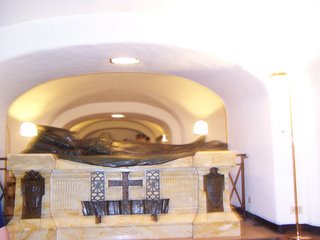
John Paul's grave is very simple,

probably because they anticipate his being raised to "Blessed" status soon. He would then be moved upstairs and placed under one of the many altars.
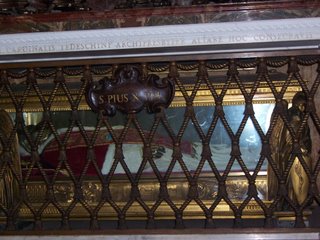
I'm just sorry that we didn't know about the Scavi tour then.
It was almost noon when we emerged so we decided to get some lunch before deciding what to do next. Just as we emerged from the Portico into the daylight a gun boomed (the "noon gun", I suppose--or was it the Angelus gun?) and a large audience clapped--the Piazza was filled with pilgrims looking to our left. We had emerged just in time for the Sunday Angelus.
So we rushed down into the crowd and tried to find a spot where we could see the Pope.

That tiny white speck in the open window is him.

After receiving our Papal Blessing, we went back into the Basilica and attended Mass at a side altar. We then sought out a restaurant in the vicinity. Our waitress was a Filipina. We noticed that we were half-way to Castel Sant'Angelo so we decided to visit there.

After thoroughly enjoying this,


we walked along the Tiber for awhile,
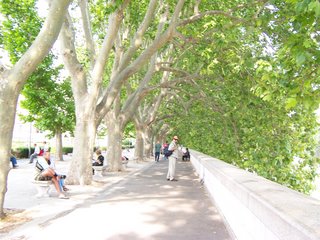
then crossed over, walked up the Via del Corso, gawking at the upscale stores along the way. We ended up at the Spanish Steps (for the last time, sigh). We boarded the Metro, changed at Termini and ended up at Metro Garbatella, our home stop. Momma's notes, which I have been relying on throughout the travelogue posts, ends here.
As was our custom, we ended our day at Il Ristorante Cinese, our favourite Italian restaurant. We said good-bye to the staff and "Momma", the proprietress, posed with us for a picture:

We finished packing that night. Tomorrow Arrivederci Roma.
Once we worked our way around the outside of the Basilica to the level underneath it both got cooler and moved quite nicely. Many different Popes are buried down there.

John Paul's grave is very simple,

probably because they anticipate his being raised to "Blessed" status soon. He would then be moved upstairs and placed under one of the many altars.

I'm just sorry that we didn't know about the Scavi tour then.
It was almost noon when we emerged so we decided to get some lunch before deciding what to do next. Just as we emerged from the Portico into the daylight a gun boomed (the "noon gun", I suppose--or was it the Angelus gun?) and a large audience clapped--the Piazza was filled with pilgrims looking to our left. We had emerged just in time for the Sunday Angelus.
So we rushed down into the crowd and tried to find a spot where we could see the Pope.

That tiny white speck in the open window is him.

After receiving our Papal Blessing, we went back into the Basilica and attended Mass at a side altar. We then sought out a restaurant in the vicinity. Our waitress was a Filipina. We noticed that we were half-way to Castel Sant'Angelo so we decided to visit there.

After thoroughly enjoying this,


we walked along the Tiber for awhile,

then crossed over, walked up the Via del Corso, gawking at the upscale stores along the way. We ended up at the Spanish Steps (for the last time, sigh). We boarded the Metro, changed at Termini and ended up at Metro Garbatella, our home stop. Momma's notes, which I have been relying on throughout the travelogue posts, ends here.
As was our custom, we ended our day at Il Ristorante Cinese, our favourite Italian restaurant. We said good-bye to the staff and "Momma", the proprietress, posed with us for a picture:

We finished packing that night. Tomorrow Arrivederci Roma.
Counterpoint
Frederica Matthewes-Green responds to Robert Miller's post about the Pope's call for an immediate ceasefire in Lebanon.
It occurred to me that while an immediate ceasefire might allow Hezbollah to claim a victory of some sort, it seems clear that Israel as well won't agree to a ceasefire until their minimum terms of victory are met. What is the direction that takes us away from the logic of violence?
It occurred to me that while an immediate ceasefire might allow Hezbollah to claim a victory of some sort, it seems clear that Israel as well won't agree to a ceasefire until their minimum terms of victory are met. What is the direction that takes us away from the logic of violence?
50,000 Canadians and Multiculturalism
A follow-up post: from Mark Steyn in Macleans about the Canadians in Lebanon. Is "Multiculturalism" in Canada bankrupt?
Are Immediate Ceasefires Always Moral?
This is the question that Robert Miller addresses at On the Square. The jury is still out for me, but he does make some interesting comparisons.
Thursday, July 27, 2006
Our Homes and Native Lands?
My brother-in-law forwarded a copy of Peter Worthington's column Convenient Canadians. It's an interesting question in this time of the global village, wondering about the ethics of Dual (or multiple) Citizenship(s).
It raises questions not only of what duties these citizens have to each of their countries, and how they ought to reconcile conflicting demands when they arise, but also what are the obligations of their countries to them. In some ways the matter is easily taken care of if each person in the world can have only one declared citizenship at any time.
But this is not workable. Poorer countries rely on expatriates to support them. They will not cut off their significant source of income by renouncing their native sons and daughters right to return home.
As long as these people are paying for the privilege of Canadian Citizenship (e.g. income tax) and are not actively supporting an enemy of Canada (hmmm), istm that they should be treated the same as the rest of us Canadians.
On the other hand, when Canadians insist on visiting dangerous areas of the world against the advice of their government they shouldn't whine when they find themselves in trouble. As to Mr. Worthington's idea of assigning second-class citizenship (of a sort) to those who take up permanent residence in other countries whose citizenship they also hold, I think a good, open, democratic debate might serve the public well.
It raises questions not only of what duties these citizens have to each of their countries, and how they ought to reconcile conflicting demands when they arise, but also what are the obligations of their countries to them. In some ways the matter is easily taken care of if each person in the world can have only one declared citizenship at any time.
But this is not workable. Poorer countries rely on expatriates to support them. They will not cut off their significant source of income by renouncing their native sons and daughters right to return home.
As long as these people are paying for the privilege of Canadian Citizenship (e.g. income tax) and are not actively supporting an enemy of Canada (hmmm), istm that they should be treated the same as the rest of us Canadians.
On the other hand, when Canadians insist on visiting dangerous areas of the world against the advice of their government they shouldn't whine when they find themselves in trouble. As to Mr. Worthington's idea of assigning second-class citizenship (of a sort) to those who take up permanent residence in other countries whose citizenship they also hold, I think a good, open, democratic debate might serve the public well.
Metro, Van, Bus, Ferry, Rowboat and Taxi
We spent most of our last Saturday in Italy travelling. The wife's sister had highly recommended visiting Capri. That involved a day-trip by bus. So we jumped on the Metro early in the morning to catch the pickup van which took us from Termini to the tour operator's office next to Santa Maria Maggiore.
It was a few hours drive south to Napoli. On the way we saw the Monte Cassino in the distance in the Appenines.
That was on our left as we travelled south. On the right we saw the Alban Hills that contain Castel Gandolfo, the Pope's Summer residence. I had the privilege of visiting there in 1972 and attending a Papal Audience. This was only early June, however, so he was still in he Vatican.
We stopped briefly at a viewpoint on the waterfront.

Then we went to the docks where all the ferries were disgorging tourists and taking hordes more for the trip to the island of Capri. Another forty-five minutes or so and we land on the island.

After a brief wait, we board a bus that takes us up the narrow winding road up to Anacapri, which towers about a thousand feet above the harbour.

We wandered along the path, lined with storefronts and restaurants. We took in the breathtaking view of the Bay of Naples, Vesuvius towering ominously over Naples in the distance, Sorrento to our right with the Amalfi Coast on the other side of the peninsula. (The girls had very much wanted us to go to Positano, well thought of from it's position in the movie Only You.)
After a gorgeous lunch in Anacapri, we board another bus and head back down the mountain to the Blue Grotto. This was and is the main point of any visit to Capri. First, there is the long line up going down the winding stairs to the water (if you come by the land-side; you wait in boats outside the Grotto if you come directly from the harbour), then we board the rowboats, four tourists at a time. then we duck under the cave entrance

and admire the glowing azure waters inside the otherwise dark cavern. Our guide sings "O Sole Mio" to cap off our experience. Total time in Grotto: five minutes or less.
I can't help thinking that I would never repeat this particular trip. If I were to go to Capri again, I'd stay in Sorrento, a short ferry ride away. A day trip to Capri would be far less taxing. And there would be an opportunity to take the bus ride down to Positano and the ferry ride back to Sorrento. Ah well, maybe one of you can do this and let me know how it works.
We board a boat to take us back to the harbour (I nearly didn't make it into the boat). We board the ferry (a jet-powered catamaran if memory serves me correctly). Jump on the bus and head back to Roma. The bus drops us off at Termini and we assume our "adventure" is at an end.
Ah, but this it Italy: new adventures wait around every corner. It turns out the Metro was down (a strike again?). How do we get back home? We hadn't yet used a taxi, so this seemed a good move. We knew enough to avoid the people who accost you on the street. These are unregistered and can involve you in misadventures of all sorts. So we lined up the proper taxi stand and took the one that rolled up when our turn came.
It was a nice young fellow, with what we assume was his girlfriend in the passenger seat, looking at some kind of documentation while he drove. Small problem: we speak three words of Italian proficiently and his English matches our Italian. "Pyramide?" No comprehension. then we remember the neighbourhoods name: "Garbatella?" Still nothing. He asks something in L'Italiano in return and all that I can manage is "Io non so". ("I don't know"). We all laugh at the absurdity of the situation and plough bravely on. We manage to get him headed south on the Via Ostiense. And we know left (sinistra) and right (destra) so we guide him to our favourite Italian restaurant and the happy end of our adventure.
It was a few hours drive south to Napoli. On the way we saw the Monte Cassino in the distance in the Appenines.
That was on our left as we travelled south. On the right we saw the Alban Hills that contain Castel Gandolfo, the Pope's Summer residence. I had the privilege of visiting there in 1972 and attending a Papal Audience. This was only early June, however, so he was still in he Vatican.
We stopped briefly at a viewpoint on the waterfront.

Then we went to the docks where all the ferries were disgorging tourists and taking hordes more for the trip to the island of Capri. Another forty-five minutes or so and we land on the island.

After a brief wait, we board a bus that takes us up the narrow winding road up to Anacapri, which towers about a thousand feet above the harbour.

We wandered along the path, lined with storefronts and restaurants. We took in the breathtaking view of the Bay of Naples, Vesuvius towering ominously over Naples in the distance, Sorrento to our right with the Amalfi Coast on the other side of the peninsula. (The girls had very much wanted us to go to Positano, well thought of from it's position in the movie Only You.)
After a gorgeous lunch in Anacapri, we board another bus and head back down the mountain to the Blue Grotto. This was and is the main point of any visit to Capri. First, there is the long line up going down the winding stairs to the water (if you come by the land-side; you wait in boats outside the Grotto if you come directly from the harbour), then we board the rowboats, four tourists at a time. then we duck under the cave entrance

and admire the glowing azure waters inside the otherwise dark cavern. Our guide sings "O Sole Mio" to cap off our experience. Total time in Grotto: five minutes or less.
I can't help thinking that I would never repeat this particular trip. If I were to go to Capri again, I'd stay in Sorrento, a short ferry ride away. A day trip to Capri would be far less taxing. And there would be an opportunity to take the bus ride down to Positano and the ferry ride back to Sorrento. Ah well, maybe one of you can do this and let me know how it works.
We board a boat to take us back to the harbour (I nearly didn't make it into the boat). We board the ferry (a jet-powered catamaran if memory serves me correctly). Jump on the bus and head back to Roma. The bus drops us off at Termini and we assume our "adventure" is at an end.
Ah, but this it Italy: new adventures wait around every corner. It turns out the Metro was down (a strike again?). How do we get back home? We hadn't yet used a taxi, so this seemed a good move. We knew enough to avoid the people who accost you on the street. These are unregistered and can involve you in misadventures of all sorts. So we lined up the proper taxi stand and took the one that rolled up when our turn came.
It was a nice young fellow, with what we assume was his girlfriend in the passenger seat, looking at some kind of documentation while he drove. Small problem: we speak three words of Italian proficiently and his English matches our Italian. "Pyramide?" No comprehension. then we remember the neighbourhoods name: "Garbatella?" Still nothing. He asks something in L'Italiano in return and all that I can manage is "Io non so". ("I don't know"). We all laugh at the absurdity of the situation and plough bravely on. We manage to get him headed south on the Via Ostiense. And we know left (sinistra) and right (destra) so we guide him to our favourite Italian restaurant and the happy end of our adventure.
Work, Work, Work
Well, that's my excuse, anyway. There have been a large number of twelve-hour shifts, with two or three day breaks in-between. But there are other things at play as well.
I've been seriously stewing over the idea of (semi-)retiring soon. (That is, cutting down to one, preferably part-time, job.) I've talked it over with the wife, filled out the forms (though they aren't mailed as yet) and notified the Employer from whom I'm retiring. The magic date is October 1.
It isn't without some anxiety and some dissatisfaction. At this point I'm waiting for Employer number two to offer me a job I've applied for. It would be an improvement in that it would be within walking distance of home (a half hour one way), and be only eight-hour shifts.
The downside is that it is full-time. Working five and occasionally six days in a row doesn't sound like semi-retirement to me. But I'll give it a try. I have three months in which to return to my part-time job at the hospital.
In the meantime, I've applied for admission to the local college and taken the English Placement Test. I'm qualified for the entry-level English course, the best possible outcome. I'll be eligible to register for a course in the late Fall for a January start. The college is just a half-hours walk away from home as well. Let's seen how this pans out.
So I'll try to finish off the travelogue and do a little commentary on things of interest in the coming weeks and months.
I've been seriously stewing over the idea of (semi-)retiring soon. (That is, cutting down to one, preferably part-time, job.) I've talked it over with the wife, filled out the forms (though they aren't mailed as yet) and notified the Employer from whom I'm retiring. The magic date is October 1.
It isn't without some anxiety and some dissatisfaction. At this point I'm waiting for Employer number two to offer me a job I've applied for. It would be an improvement in that it would be within walking distance of home (a half hour one way), and be only eight-hour shifts.
The downside is that it is full-time. Working five and occasionally six days in a row doesn't sound like semi-retirement to me. But I'll give it a try. I have three months in which to return to my part-time job at the hospital.
In the meantime, I've applied for admission to the local college and taken the English Placement Test. I'm qualified for the entry-level English course, the best possible outcome. I'll be eligible to register for a course in the late Fall for a January start. The college is just a half-hours walk away from home as well. Let's seen how this pans out.
So I'll try to finish off the travelogue and do a little commentary on things of interest in the coming weeks and months.
Saturday, July 01, 2006
What He Said
There's only a couple of days left in the travelogue. While I sort out the details of life that lure me away from this, here's a post from AMDG that speaks to my state of life and mind.
Friday, June 23, 2006
The Little David and Underground Adventure
We saw "Big David" in Firenza. He is massive and Renaissance. But today we move on to a more human-sized David and the Baroque.
The Villa Borghese is just outside the walls of Rome. A metro ride to the Spanish Steps and a walk across the grounds brings us to the Villa proper, which houses the Gallery.
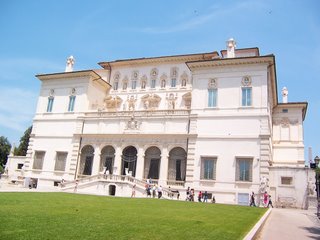
You have to make reservations to get inside, so do so as soon as you arrive in Rome. We joined the English-language tour. This because you are limited to two hours in the Gallery and we wanted to maximize our experience.
There is, once again, too much to take in in one visit. But the two items that stand out in my memory are Bernini's Apollo and Daphne and David. Momma was impressed by the latter, preferring it to Michelangelo's. But it is the Apollo and Daphne that I am most impressed by. The guide carefully walked us around the sculpture, showing us how from the four cardinal points, a different part of the story seems to told. Fascinating.
We then re-board the Metro to travel to south-east Rome (Momma declined to ride the Hot Air Balloon, which would have given us a wonderful view of the city). In a busy commercial centre we board a bus and travel through the outer limits of Rome to the end of the line. We get off and walk a little way to an old stone road: Via Appia Antica. Momma, by now, was beginning to suffer from all the walking we had been doing. So her recollection of this walk is less favourable than mine.
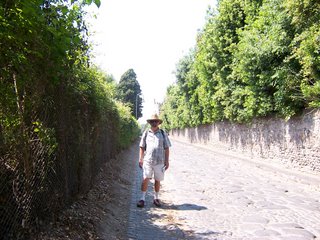
Cypress-lined and just shady enough to keep the worst of the heat off of us. We walk through an ancient gate and on toward St. Callixtus' catacombs. We find some shade and wait for the English-language tour.
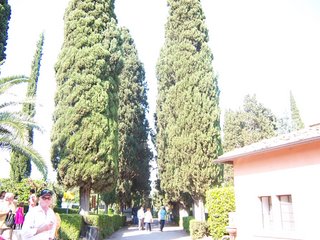
Then down into the world of ancient Roman Christians
We then continue our adventurous ways and board a bus to see if we can get to San Giovanni in Laterano on it. I was there in '72 and remember the front. When we get off the bus however, it doesn't look familiar to me.
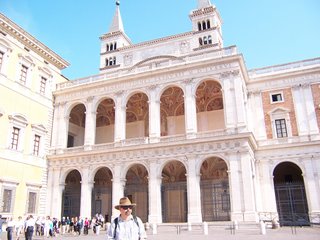
Later we realize that we have entered by the side. Inside we are suitably awestruck.
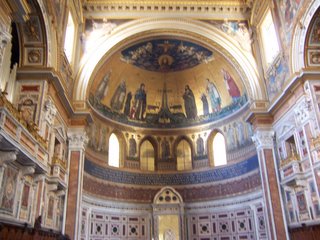
When we exit from the front I now recognize the view. We have now visited all four of the four major basilicas of Rome.
We cross the street to visit the Scala Santa. Momma wanted to do the traditional thing and go up the steps on her knees. Perhaps, I was being too worldly, but I'm worried about her arthritic knees and talk her out of it. (This is traditional in Lent and on Fridays--guess which day this was.) So we walk up the side stairs and visit the Sancta Sanctorum. We find our way to a Metro station; back home for Chinese.
"Tomorrow" we travel to Capri.
The Villa Borghese is just outside the walls of Rome. A metro ride to the Spanish Steps and a walk across the grounds brings us to the Villa proper, which houses the Gallery.

You have to make reservations to get inside, so do so as soon as you arrive in Rome. We joined the English-language tour. This because you are limited to two hours in the Gallery and we wanted to maximize our experience.
There is, once again, too much to take in in one visit. But the two items that stand out in my memory are Bernini's Apollo and Daphne and David. Momma was impressed by the latter, preferring it to Michelangelo's. But it is the Apollo and Daphne that I am most impressed by. The guide carefully walked us around the sculpture, showing us how from the four cardinal points, a different part of the story seems to told. Fascinating.
We then re-board the Metro to travel to south-east Rome (Momma declined to ride the Hot Air Balloon, which would have given us a wonderful view of the city). In a busy commercial centre we board a bus and travel through the outer limits of Rome to the end of the line. We get off and walk a little way to an old stone road: Via Appia Antica. Momma, by now, was beginning to suffer from all the walking we had been doing. So her recollection of this walk is less favourable than mine.

Cypress-lined and just shady enough to keep the worst of the heat off of us. We walk through an ancient gate and on toward St. Callixtus' catacombs. We find some shade and wait for the English-language tour.

Then down into the world of ancient Roman Christians
We then continue our adventurous ways and board a bus to see if we can get to San Giovanni in Laterano on it. I was there in '72 and remember the front. When we get off the bus however, it doesn't look familiar to me.

Later we realize that we have entered by the side. Inside we are suitably awestruck.

When we exit from the front I now recognize the view. We have now visited all four of the four major basilicas of Rome.
We cross the street to visit the Scala Santa. Momma wanted to do the traditional thing and go up the steps on her knees. Perhaps, I was being too worldly, but I'm worried about her arthritic knees and talk her out of it. (This is traditional in Lent and on Fridays--guess which day this was.) So we walk up the side stairs and visit the Sancta Sanctorum. We find our way to a Metro station; back home for Chinese.
"Tomorrow" we travel to Capri.
Back from the Silence
I've been laid low the last week and a half or so, So at least I have an excuse for the lack of blogging. I'm feeling a little better today, so let's try to finish off the travelogue from last year.
This day illustrates another aspect of the Italian adventure: having Lorna experience some of the places that I had seen in '72.
A trip to Assisi on our own would have been more adventurous, but bus trips have countervailing advantages. So we decided on the bus day-trip.
We were picked up by taxi at the Termini station and taken over to the office, across the street, more or less, from Santa Maria Maggiore.
A lovely day to ride through Umbria. Our first stop is Orvieto. In California we would have said that the city is situated on a mesa. The touristy way to get up there is to take the tram.

But there's a road up there since, once we got to the top, we used the bus service to get to the cathedral, the centrepiece of our visit.

The facade is beautiful and fascinating (don't those two go together?). The story of how the cathedral came to be built is also interesting, but a warning is owed to the more, um, spiritual among the readers. Catholicism is way too incarnational for the taste and sensitivities of some. Read on at your own peril.
Eucharistic miracles are plentiful in church history. The ancient belief in Christ's Body and Blood being made present in the Eucharist has challenged many, including those serving the Church as priests. Long story short, a pilgrim priest from "Germany" (so how come his name is Peter of Prague?) has his doubts about the Real Presence resolved when the newly consecrated Host starts bleeding, leaving bloodstains on the corporal. The startled priest goes to nearby Orvieto to see the Pope who orders the cloth to be kept in the cathedral. He orders the city to upgrade the church to reflect the importance of the relic and so we have this wonderful edifice to admire. And now the Church celebrates the feast of Corpus Christi every year as a result of this miracle.
The frescos by Fra Angelico and Signorelli were breathtaking.
We return down the tram to the bus and cross the hilly Umbrian countryside to Assisi.

First we start with the multilevel Basilica of San Francesco d'Assisi, the renovations of which were completed this year. Again, frescos by Ciimabue and Giotto are worth contemplating. We then walked across the town

to the Church of Saint Clare (a gorgeous pink colour).

We return to the bus and go down the valley to see the Basilica, inside of which, interestingly, the original church (the Porziuncola) assigned to Saint Francis is housed.
A good deal of this day, from Basilica to Church to Basilica, was spent talking is hushed tones and gawking. A pilgrimage day.
I'll pass over the unpleasantness between the driver and the guide. Suffice it to say that there are occasional incidents that illustrate the vices of hyper-masculinity. Otherwise a lovely and edifying day.
"Tomorrow" we feast our eyes and minds at the Villa Borghese, then climb down into the catacombs.
This day illustrates another aspect of the Italian adventure: having Lorna experience some of the places that I had seen in '72.
A trip to Assisi on our own would have been more adventurous, but bus trips have countervailing advantages. So we decided on the bus day-trip.
We were picked up by taxi at the Termini station and taken over to the office, across the street, more or less, from Santa Maria Maggiore.
A lovely day to ride through Umbria. Our first stop is Orvieto. In California we would have said that the city is situated on a mesa. The touristy way to get up there is to take the tram.

But there's a road up there since, once we got to the top, we used the bus service to get to the cathedral, the centrepiece of our visit.

The facade is beautiful and fascinating (don't those two go together?). The story of how the cathedral came to be built is also interesting, but a warning is owed to the more, um, spiritual among the readers. Catholicism is way too incarnational for the taste and sensitivities of some. Read on at your own peril.
Eucharistic miracles are plentiful in church history. The ancient belief in Christ's Body and Blood being made present in the Eucharist has challenged many, including those serving the Church as priests. Long story short, a pilgrim priest from "Germany" (so how come his name is Peter of Prague?) has his doubts about the Real Presence resolved when the newly consecrated Host starts bleeding, leaving bloodstains on the corporal. The startled priest goes to nearby Orvieto to see the Pope who orders the cloth to be kept in the cathedral. He orders the city to upgrade the church to reflect the importance of the relic and so we have this wonderful edifice to admire. And now the Church celebrates the feast of Corpus Christi every year as a result of this miracle.
The frescos by Fra Angelico and Signorelli were breathtaking.
We return down the tram to the bus and cross the hilly Umbrian countryside to Assisi.

First we start with the multilevel Basilica of San Francesco d'Assisi, the renovations of which were completed this year. Again, frescos by Ciimabue and Giotto are worth contemplating. We then walked across the town

to the Church of Saint Clare (a gorgeous pink colour).

We return to the bus and go down the valley to see the Basilica, inside of which, interestingly, the original church (the Porziuncola) assigned to Saint Francis is housed.
A good deal of this day, from Basilica to Church to Basilica, was spent talking is hushed tones and gawking. A pilgrimage day.
I'll pass over the unpleasantness between the driver and the guide. Suffice it to say that there are occasional incidents that illustrate the vices of hyper-masculinity. Otherwise a lovely and edifying day.
"Tomorrow" we feast our eyes and minds at the Villa Borghese, then climb down into the catacombs.
Sunday, June 18, 2006
Courage, Fear, Thieves, Deception and Truthfulness
Once again we walked boldly out the lobby in the morning, armed with sixteen words of Italian, our book and plenty of pluck. First we took the Metro to the Ponte Mammolo stop, well north of downtown, and catch a Cotral bus to Tivoli.
and plenty of pluck. First we took the Metro to the Ponte Mammolo stop, well north of downtown, and catch a Cotral bus to Tivoli.
Bus drivers in Rome are generally disinterested in their passengers, especially the obviously touristy ones. You pay your fare at kiosks or automated machines. Some of the buses are equipped with readers that you stick the ticket into. The driver has nothing to do with collecting money or tickets. So we were on our own trying to figure out which stop to get off at.
The bus crossed the plains of Lazio, passed by the stop for the Villa Adriana (Momma had announced in no uncertain terms that the Via Sacra and the Roman Forum was the last bit of ancient ruins she ever cared to walk through again) and climbed the hill above. So we knew we were close to Tivoli. But exactly which stop should we get off at? However a lovely Italian gentleman deduced our problem and escorted us off the bus at the appropriate stop, pointing out the Villa d'Este as we parted.
A few pictures to remember this by.
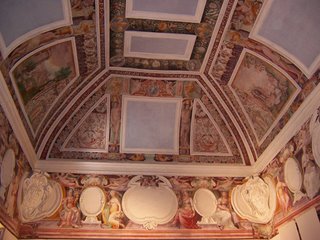
The water organ sounded lovely (it plays once a day), but we were too far away to hear it clearly and it was too short.

A cafeteria style lunch, some shopping at the stores and kiosks outside and we board a bus back to Roma. It didn't help that the bus didn't take the same route back that we had taken there. So there were some anxious minutes before we pulled into the Ponte Mammolo stop again.
Down Metro "B" to Termini, through the subterranean passages to Metro "A" and off to the Vatican. (the Metro crosses Rome like a big "X"'; lines "A" and "B" intersecting at Termini.)
We had learned from yesterday's episode. I had packed some long pants in my backpack. A discrete visit to the men's room and I'm decent. We pass triumphantly through the security and reflexively we join the first line we see. I'm gazing around mildly confused. Why were we standing in line to get into San Pietro? Then I see that the entrance is actually behind us, in the centre of the Portico. So what line are we in?
Gasp! We're in the line-up for the Cupola (Il Cupolone to the locals). My wife strongly dislikes climbing. Oh dear, what to do? So I simply say nothing, waiting for us to be so far along that it would seem a waste to turn away. Once the ticket booth is in sight (a half-hour or so), I'm ready to say, in my best surprised voice, "Oh dear, this the line for the Cupola!" Once assured that there's an elevator (half-way to the top), Momma is satisfied.
While we're waiting in that line I feel a tug on my backpack. So I turn to my left to see if someone behind me is trying to get my attention. But the backpack is stuck on something to my right, which I can't see. By the time I wrench myself free to turn left and see what's going on behind me, I see a green-shirted man disappearing back up the line behind us. We had already been prepared for this; there was nothing of value in the backpack. Still it seemed mildly sacrilegious to be thieving at San Pietro.
I walked up the spiral staircase (on principle) while Momma took the elevator. That put us inside the Cupola looking down at the central altar. After a little while we turned to the exit. I knew from Rick Steves' book that there is a further climb to view Roma from the outside. But honesty prevailed. I read Rick's description from the book:
As I expected Momma declined, but agreed to wait for me down in the Church proper. She followed me a few steps up so she could take a picture out a window in the Dome. I plunged on. Rick Steves' description is no exaggeration. Some Europeans, perhaps Austrians were in front of me. So while I huffed and puffed behind them they kept looking back nervously, apparently waiting for me to have a cardiac arrest. But, lungs bursting, I made it to the top. I slowly made my way around the outside, crowded and friendly. I thought to myself that I would go slowly in order to be able to tell Momma that I had given her time to follow me. Ha! As if!
Nearly all the way around and ready to start back down again who do I meet? Smiling, no hint of the labour just accomplished: Momma! She attributes this to divine intervention and I'm in no position to disagree. Anyway, it was the perfect day and the best possible view of Rome.
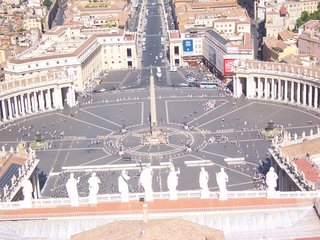
We walk through the Basilica in complete awe: the Pieta; the altars, the bodies of saintly popes (there were one or two) inside some of them; the main altar. Just like the Vatican Museum, it was all too much to take in.

"Tomorrow" we take a day trip to Assisi. Saint Francis pray for us.
Bus drivers in Rome are generally disinterested in their passengers, especially the obviously touristy ones. You pay your fare at kiosks or automated machines. Some of the buses are equipped with readers that you stick the ticket into. The driver has nothing to do with collecting money or tickets. So we were on our own trying to figure out which stop to get off at.
The bus crossed the plains of Lazio, passed by the stop for the Villa Adriana (Momma had announced in no uncertain terms that the Via Sacra and the Roman Forum was the last bit of ancient ruins she ever cared to walk through again) and climbed the hill above. So we knew we were close to Tivoli. But exactly which stop should we get off at? However a lovely Italian gentleman deduced our problem and escorted us off the bus at the appropriate stop, pointing out the Villa d'Este as we parted.
A few pictures to remember this by.

The water organ sounded lovely (it plays once a day), but we were too far away to hear it clearly and it was too short.

A cafeteria style lunch, some shopping at the stores and kiosks outside and we board a bus back to Roma. It didn't help that the bus didn't take the same route back that we had taken there. So there were some anxious minutes before we pulled into the Ponte Mammolo stop again.
Down Metro "B" to Termini, through the subterranean passages to Metro "A" and off to the Vatican. (the Metro crosses Rome like a big "X"'; lines "A" and "B" intersecting at Termini.)
We had learned from yesterday's episode. I had packed some long pants in my backpack. A discrete visit to the men's room and I'm decent. We pass triumphantly through the security and reflexively we join the first line we see. I'm gazing around mildly confused. Why were we standing in line to get into San Pietro? Then I see that the entrance is actually behind us, in the centre of the Portico. So what line are we in?
Gasp! We're in the line-up for the Cupola (Il Cupolone to the locals). My wife strongly dislikes climbing. Oh dear, what to do? So I simply say nothing, waiting for us to be so far along that it would seem a waste to turn away. Once the ticket booth is in sight (a half-hour or so), I'm ready to say, in my best surprised voice, "Oh dear, this the line for the Cupola!" Once assured that there's an elevator (half-way to the top), Momma is satisfied.
While we're waiting in that line I feel a tug on my backpack. So I turn to my left to see if someone behind me is trying to get my attention. But the backpack is stuck on something to my right, which I can't see. By the time I wrench myself free to turn left and see what's going on behind me, I see a green-shirted man disappearing back up the line behind us. We had already been prepared for this; there was nothing of value in the backpack. Still it seemed mildly sacrilegious to be thieving at San Pietro.
I walked up the spiral staircase (on principle) while Momma took the elevator. That put us inside the Cupola looking down at the central altar. After a little while we turned to the exit. I knew from Rick Steves' book that there is a further climb to view Roma from the outside. But honesty prevailed. I read Rick's description from the book:
The staircase...actually winds between the outer shell and the inner one. It 's a sweaty, crowded, claustrophobic, 15-minute, 323-step climb. But worth it.
As I expected Momma declined, but agreed to wait for me down in the Church proper. She followed me a few steps up so she could take a picture out a window in the Dome. I plunged on. Rick Steves' description is no exaggeration. Some Europeans, perhaps Austrians were in front of me. So while I huffed and puffed behind them they kept looking back nervously, apparently waiting for me to have a cardiac arrest. But, lungs bursting, I made it to the top. I slowly made my way around the outside, crowded and friendly. I thought to myself that I would go slowly in order to be able to tell Momma that I had given her time to follow me. Ha! As if!
Nearly all the way around and ready to start back down again who do I meet? Smiling, no hint of the labour just accomplished: Momma! She attributes this to divine intervention and I'm in no position to disagree. Anyway, it was the perfect day and the best possible view of Rome.

We walk through the Basilica in complete awe: the Pieta; the altars, the bodies of saintly popes (there were one or two) inside some of them; the main altar. Just like the Vatican Museum, it was all too much to take in.

"Tomorrow" we take a day trip to Assisi. Saint Francis pray for us.
Do-Overs, Flexibility and Scandal
We arrived bright and early after our continental breakfast (which we grew to look forward to) in the lobby looking forward to a real adventure. We would take the Metro north of Rome, connect to a bus line and ride for twenty miles or so to the town of Tivoli, with the famous gardens.
I should confess now that a good deal of what we did and how we did it in Italy was a Do-Over for me. I had visited Italy in the Summer of '72, a foolish, hasty young man. Five days in Rome, were spent wandering around aimlessly, avoiding any activities the people I was with were doing. One of the trips I had foregone was a trip to Tivoli. That was in the back of my mind when I planned this trip.
However, this is an adventure, and that requires flexibility. And this is Italy, which requires a certain detachment from time schedules and plans. Anyway, in the lobby as we about to head for the Metro stop a nun (of the order who owns the Villa), who was talking to the nice young lady behind the desk, said something (in L'Italiano) that caught our attention. So we enquired. The Metro is on strike.
First, we experience a wave of disappointment, then we ask: how we get around Rome if the Metro is on strike? Answer: the train. The station is only three blocks away and it is still running. And we can cross over the Tiber through Trestavere and get off at a stop not far from the Vatican. So off we go.
We once again choose to ignore the bus system once we get off the train and walk several blocks to the Vatican. We enter from the south side, cross over the Piazza San Pietro to the north side looking for the entrance to the Vatican Museum. And here we begin a major do-over for me. Thirty-three years ago I had realized that I hadn't seen the Museum as our five days fled away. So I rushed over one afternoon, practically ran through the exhibits, rushed into the Sistine, looked up, and rushed out. Today we will do it right.
Now I was a little bit anxious because I had dressed in the morning for Tivoli, not the Vatican, where there is is a dress code. I had some longish shorts on. So I slid the pants down as far as modesty would allow, nearly covering my knees and entered. No problems.
I won't include a lot of pictures, we took so many. But a few points I'd like to make. We walked slowly for the entire time (about three hours all told), but it still wasn't near enough. Several visits of several hours each might suffice.

Anyway, we looked out at the Pope's private gardens behind Saint Peter's.

We gawked at the wealth of antiquities
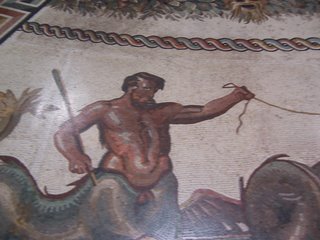
and objet d'art.

It was overwhelming. We cross over to the Stanza di Raffaello for even more.
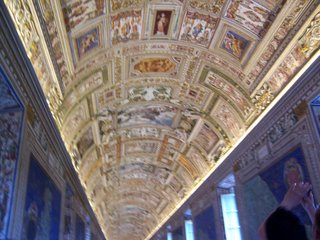
And the Sistine Chapel: we walked in, clutching our Rick Steves's book, with it's description of the Chapel. We sidled over to the wooden bench in the wall and waited patiently for a spot to open up for us. Then we sat down and strained our necks looking around. A constant flow of humanity passed by us, murmuring and shuffling. We whispered occasionally and pointed to various aspects of Chapel. When we were satisfied that we had soaked up as much as we could (twenty minutes or so), we took a "secret" exit that deposited us right in the Portico of Saint Peter's. (You would normally have to take the regular exit, going all the way back, entering the Piazza San Pietro and go through line-ups and security again).
So we made it inside for the first time. And what do we decide to do: eat. We promptly leave, find an expensive but ordinary lunch. Then we return looking for the English-language tour. A seminarian on his day off (probably from the North American College) was in charge. Once the group is large enough we proceed to the security area.
So, again, I slide my scandalous shorts down to cover my knees. I was confidant because we had done it once already and many attractive women with short skirts were getting through. And we made it.
But just inside the great Portico as we're beginning the tour proper, I hear a voice: "No!". I turn around and there is a grim-faced official wagging his finger and pointing me to the exit. Oh well, the girls did have nicer looking legs. We'll just have to come back another day.
We wandered back to the train station and noticed the bus loop there. The Metro strike was scheduled to end at 5 p.m., so we decided to go downtown and wander around until then. This put is on Bus #64 (sessantaquattro), which leads to a fine tour of Rome, if you don't mind pickpockets and being packed like sardines. We got a seat so we didn't.
We stop a couple of blocks short of Termini to visit the Museo Nazionale Romano. More gorgeous antiquities, but by now our feet are complaining. So back to Termini, on the Metro and back home, by way of Chinese food.
Tomorrow we will attempt Tivoli again.
I should confess now that a good deal of what we did and how we did it in Italy was a Do-Over for me. I had visited Italy in the Summer of '72, a foolish, hasty young man. Five days in Rome, were spent wandering around aimlessly, avoiding any activities the people I was with were doing. One of the trips I had foregone was a trip to Tivoli. That was in the back of my mind when I planned this trip.
However, this is an adventure, and that requires flexibility. And this is Italy, which requires a certain detachment from time schedules and plans. Anyway, in the lobby as we about to head for the Metro stop a nun (of the order who owns the Villa), who was talking to the nice young lady behind the desk, said something (in L'Italiano) that caught our attention. So we enquired. The Metro is on strike.
First, we experience a wave of disappointment, then we ask: how we get around Rome if the Metro is on strike? Answer: the train. The station is only three blocks away and it is still running. And we can cross over the Tiber through Trestavere and get off at a stop not far from the Vatican. So off we go.
We once again choose to ignore the bus system once we get off the train and walk several blocks to the Vatican. We enter from the south side, cross over the Piazza San Pietro to the north side looking for the entrance to the Vatican Museum. And here we begin a major do-over for me. Thirty-three years ago I had realized that I hadn't seen the Museum as our five days fled away. So I rushed over one afternoon, practically ran through the exhibits, rushed into the Sistine, looked up, and rushed out. Today we will do it right.
Now I was a little bit anxious because I had dressed in the morning for Tivoli, not the Vatican, where there is is a dress code. I had some longish shorts on. So I slid the pants down as far as modesty would allow, nearly covering my knees and entered. No problems.
I won't include a lot of pictures, we took so many. But a few points I'd like to make. We walked slowly for the entire time (about three hours all told), but it still wasn't near enough. Several visits of several hours each might suffice.

Anyway, we looked out at the Pope's private gardens behind Saint Peter's.

We gawked at the wealth of antiquities

and objet d'art.

It was overwhelming. We cross over to the Stanza di Raffaello for even more.

And the Sistine Chapel: we walked in, clutching our Rick Steves's book, with it's description of the Chapel. We sidled over to the wooden bench in the wall and waited patiently for a spot to open up for us. Then we sat down and strained our necks looking around. A constant flow of humanity passed by us, murmuring and shuffling. We whispered occasionally and pointed to various aspects of Chapel. When we were satisfied that we had soaked up as much as we could (twenty minutes or so), we took a "secret" exit that deposited us right in the Portico of Saint Peter's. (You would normally have to take the regular exit, going all the way back, entering the Piazza San Pietro and go through line-ups and security again).
So we made it inside for the first time. And what do we decide to do: eat. We promptly leave, find an expensive but ordinary lunch. Then we return looking for the English-language tour. A seminarian on his day off (probably from the North American College) was in charge. Once the group is large enough we proceed to the security area.
So, again, I slide my scandalous shorts down to cover my knees. I was confidant because we had done it once already and many attractive women with short skirts were getting through. And we made it.
But just inside the great Portico as we're beginning the tour proper, I hear a voice: "No!". I turn around and there is a grim-faced official wagging his finger and pointing me to the exit. Oh well, the girls did have nicer looking legs. We'll just have to come back another day.
We wandered back to the train station and noticed the bus loop there. The Metro strike was scheduled to end at 5 p.m., so we decided to go downtown and wander around until then. This put is on Bus #64 (sessantaquattro), which leads to a fine tour of Rome, if you don't mind pickpockets and being packed like sardines. We got a seat so we didn't.
We stop a couple of blocks short of Termini to visit the Museo Nazionale Romano. More gorgeous antiquities, but by now our feet are complaining. So back to Termini, on the Metro and back home, by way of Chinese food.
Tomorrow we will attempt Tivoli again.
What Do You Do After Laundry?
"Walk" was our answer. We took the Metro downtown to do our laundry in the morning. We returned for lunch in our favourite restaurant. (Ordering spaghetti in Il Ristorante Cinese gets you something different from the conventional Italian dish).
I had wanted to do the Evening stroll through Rome we saw in Rick Steves' book . And since we hadn't actually gone inside the Colosseum as yet, that seemed a good afternoon activity.
. And since we hadn't actually gone inside the Colosseum as yet, that seemed a good afternoon activity.

First we passed by the Arch of Constantine,

and through the Arch of Titus.

Then we went along the Via Sacra and marvelled at the ancient ruins of the Roman Forum.
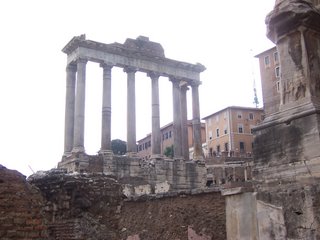
The start of the "Night Walk Across Rome" starts in Campo de' Fiori, which was still some distance away. So I suggested a taxi, but Momma, who despite disliking walking, insisted this would be a waste of money.
So at the end of Via Sacra we climbed (did I mention she intensely dislikes climbing?) up and over the Capitoline Hill and around to the front of the Victor Emmanuel Monument.

From here we crossed the Piazza Venezia and turned left. We passed by the Gesu (under wraps as they refurbish it) and came to the Largo Argentina. It's a deep excavation about the size of city block in the middle of a the busy downtown area.
Here we turned left again and paused for Gelati. Then we headed off in search of Campo de' Fiori.
Now the walking begins in earnest, with the Romans, doing their customary evening stroll, joining us. Just the highlights from here. From Campo de' Fiori to Piazza Navona; to the Pantheon;

To the Trevi Fountain,
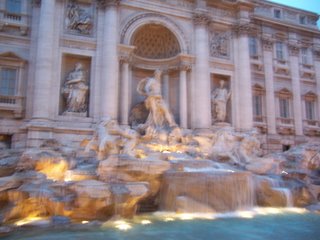
And, after a quiet dinner and some wandering around, the Piazza di Spagna
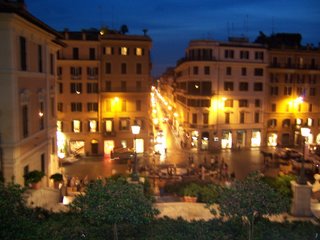
and the Spanish Steps.
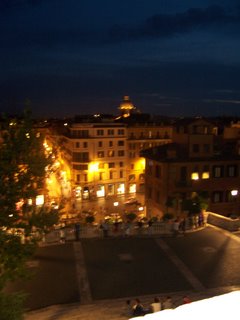
This should have been the end of a very long walk, but just as we entered the Metro Station there Security closed it down. Again, Momma objected to a taxi ride so we walked under the Quirinale Hill and after several rest breaks, passing by the Baths of Diocletian all the way to Termini. Almost a complete circuit of downtown Roma on foot.
I don't think Momma's feet ever quite recovered from this marathon. "Tomorrow" we are planning to go the the Tivoli Gardens, but Roma had something else in mind.
I had wanted to do the Evening stroll through Rome we saw in Rick Steves' book

First we passed by the Arch of Constantine,

and through the Arch of Titus.

Then we went along the Via Sacra and marvelled at the ancient ruins of the Roman Forum.

The start of the "Night Walk Across Rome" starts in Campo de' Fiori, which was still some distance away. So I suggested a taxi, but Momma, who despite disliking walking, insisted this would be a waste of money.
So at the end of Via Sacra we climbed (did I mention she intensely dislikes climbing?) up and over the Capitoline Hill and around to the front of the Victor Emmanuel Monument.

From here we crossed the Piazza Venezia and turned left. We passed by the Gesu (under wraps as they refurbish it) and came to the Largo Argentina. It's a deep excavation about the size of city block in the middle of a the busy downtown area.
Here we turned left again and paused for Gelati. Then we headed off in search of Campo de' Fiori.
Now the walking begins in earnest, with the Romans, doing their customary evening stroll, joining us. Just the highlights from here. From Campo de' Fiori to Piazza Navona; to the Pantheon;

To the Trevi Fountain,

And, after a quiet dinner and some wandering around, the Piazza di Spagna

and the Spanish Steps.

This should have been the end of a very long walk, but just as we entered the Metro Station there Security closed it down. Again, Momma objected to a taxi ride so we walked under the Quirinale Hill and after several rest breaks, passing by the Baths of Diocletian all the way to Termini. Almost a complete circuit of downtown Roma on foot.
I don't think Momma's feet ever quite recovered from this marathon. "Tomorrow" we are planning to go the the Tivoli Gardens, but Roma had something else in mind.
Saturday, June 17, 2006
The Lord's Day
We spent our first Sunday in Rome visiting churches. Very appropriate don't you think?
The first church was for Mass, the local parish church Chiesa di Santa Galla. The wife was little self-conscious as the only Asian in a sea of Italians. After eating a light lunch in the neighbourhood, we boarded the Metro and headed north to Termini.
From this central hub of the Roman transportation system we walked to Santa Maria Maggiore, another one of the great Basilicas of Rome. We also wandered around this area and visted several more churches, including Santa Prassede.
Then we worked our way back towards the Colosseum, first climbing up to San Pietro in Vincoli, where we admired the chains of Saint Peter and Michelangelo's Moses. Then we walked by the Colosseum on our way to San Clemente, so old that it was ten or more feet below the street level.
We return "home" via the Metro, eat at our favourite Italian Restaurant (Il Ristorante Cinese) and go to bed. Tomorrow is our laundry day (we found a coin-operated laundry "today"near Termini). But it will be a memorable day, nonetheless.
The first church was for Mass, the local parish church Chiesa di Santa Galla. The wife was little self-conscious as the only Asian in a sea of Italians. After eating a light lunch in the neighbourhood, we boarded the Metro and headed north to Termini.
From this central hub of the Roman transportation system we walked to Santa Maria Maggiore, another one of the great Basilicas of Rome. We also wandered around this area and visted several more churches, including Santa Prassede.
Then we worked our way back towards the Colosseum, first climbing up to San Pietro in Vincoli, where we admired the chains of Saint Peter and Michelangelo's Moses. Then we walked by the Colosseum on our way to San Clemente, so old that it was ten or more feet below the street level.
We return "home" via the Metro, eat at our favourite Italian Restaurant (Il Ristorante Cinese) and go to bed. Tomorrow is our laundry day (we found a coin-operated laundry "today"near Termini). But it will be a memorable day, nonetheless.
Friday, June 16, 2006
How Time Flies!
So we wake up, call a taxi and go to the Piramide district of Rome to see our new home for the first time: Villa Benedetta.
Once we had claimed our room, our first order of business was to acquaint ourselves with the neighbourhood. So we walked around a little, seeing the Pyramid the district got it's name from. We then boarded the Metro and travelled south a couple of stops. We wanted to see the great Basilica San Paolo Fuori le Mura.

After enjoying this thoroughly, we decided to walk up the Via Ostiense to see a museum associated with the Capitoline (which is downtown). It is a former power station with ancient sculptures and sarcophaghi.
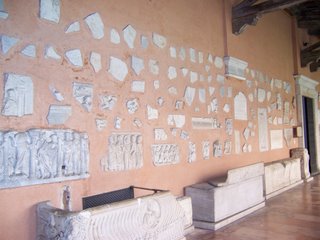
(These are from San Paolo, but you get the idea.)
We walked back to the Villa, discovering two interesting things. First, we were only two blocks from a Metro stop, which we would use extensively during our stay. Two, right across the street from the Metro stop was Il Ristorante Cinese (in L'inglese: a Chinese restaurant). After sixteen days at sea and five days of busing around Italy, my Filipina wife suddenly remembers she's Oriental and has cravings for rice and proper Oriental food. We ate there everyday for the rest of our stay.
Tomorrow we tackle downtown Rome all by ourselves.
Once we had claimed our room, our first order of business was to acquaint ourselves with the neighbourhood. So we walked around a little, seeing the Pyramid the district got it's name from. We then boarded the Metro and travelled south a couple of stops. We wanted to see the great Basilica San Paolo Fuori le Mura.

After enjoying this thoroughly, we decided to walk up the Via Ostiense to see a museum associated with the Capitoline (which is downtown). It is a former power station with ancient sculptures and sarcophaghi.

(These are from San Paolo, but you get the idea.)
We walked back to the Villa, discovering two interesting things. First, we were only two blocks from a Metro stop, which we would use extensively during our stay. Two, right across the street from the Metro stop was Il Ristorante Cinese (in L'inglese: a Chinese restaurant). After sixteen days at sea and five days of busing around Italy, my Filipina wife suddenly remembers she's Oriental and has cravings for rice and proper Oriental food. We ate there everyday for the rest of our stay.
Tomorrow we tackle downtown Rome all by ourselves.
It's Tomorrow Already
Given that I'm a couple of weeks behind, I'll try to wrap up this day-by-day journal of last year's trip expeditiously.
The major difference between the bus tour and the rest of our trip (the cruise and the stay in Rome) was the almost complete lack of adventure. While we focused on avoiding the tour groups and going our own way during those phases, here, while away from Rome, we concentrated on all the tours. That's the advantage of bus tours: risk is minimized, value (touristically speaking) maximized. Remember, adventures can be both good and bad.
In keeping with the theory that we would never be coming this way again, we decided to take the San Gimignano tour rather than wander around Firenza. Ah Tuscany!

"Hill town" means climbing, even after the bus parks. At the height of the town, facing the main square, Piazza Duomo, was the main tower and the Duomo. I climbed the tower and admired the People's Palace,

while Momma visited the Church.
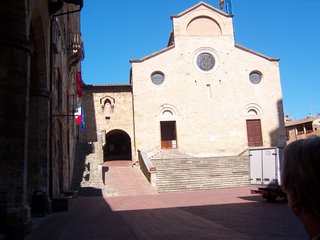
We then climbed to the height of the town and admired the surrounding Tuscan countryside. One last view of the Tuscan hills from San Gimignano.

Some Gelati and a couple of bottles of wine (purchased , not drank) later, we climbed back down the hill.
So we board the bus, return to Firenza to pick up the adventurers and go to Rome. Tomorrow we say good-bye to our guide, driver, and travel-mates. Tonight we skip the Farewell Dinner and walk with some fellow tourists to the Italian equivalent of a small strip-mall. (We were still on the outskirts of Roma where things North American are being tenuously introduced.) We ate at a a pizza joint called That's Amore. Given we spoke almost no Italian and they spoke no English, it was fun. Unfortunately, the multiplex theatre didn't have any English-subtitled versions of Star Wars 3. You have to go downtown for English-language movies. We returned for our last night in a First Class Hotel, eager and anxious about the our nine-day Roman expedition.
"Tomorrow" the adventure resumes.
The major difference between the bus tour and the rest of our trip (the cruise and the stay in Rome) was the almost complete lack of adventure. While we focused on avoiding the tour groups and going our own way during those phases, here, while away from Rome, we concentrated on all the tours. That's the advantage of bus tours: risk is minimized, value (touristically speaking) maximized. Remember, adventures can be both good and bad.
In keeping with the theory that we would never be coming this way again, we decided to take the San Gimignano tour rather than wander around Firenza. Ah Tuscany!

"Hill town" means climbing, even after the bus parks. At the height of the town, facing the main square, Piazza Duomo, was the main tower and the Duomo. I climbed the tower and admired the People's Palace,

while Momma visited the Church.

We then climbed to the height of the town and admired the surrounding Tuscan countryside. One last view of the Tuscan hills from San Gimignano.

Some Gelati and a couple of bottles of wine (purchased , not drank) later, we climbed back down the hill.
So we board the bus, return to Firenza to pick up the adventurers and go to Rome. Tomorrow we say good-bye to our guide, driver, and travel-mates. Tonight we skip the Farewell Dinner and walk with some fellow tourists to the Italian equivalent of a small strip-mall. (We were still on the outskirts of Roma where things North American are being tenuously introduced.) We ate at a a pizza joint called That's Amore. Given we spoke almost no Italian and they spoke no English, it was fun. Unfortunately, the multiplex theatre didn't have any English-subtitled versions of Star Wars 3. You have to go downtown for English-language movies. We returned for our last night in a First Class Hotel, eager and anxious about the our nine-day Roman expedition.
"Tomorrow" the adventure resumes.
Subscribe to:
Posts (Atom)






